The Explosive Growth of Healthcare Digital Twins: A Market Set to Hit $38.43 Billion by 2032

The healthcare industry is on the cusp of a digital revolution, with digital twin technology leading the charge. According to recent market analysis, the global healthcare digital twin market was valued at $1.17 billion in 2022 and is projected to skyrocket to $38.43 billion by 2032. This remarkable growth represents a compound annual growth rate (CAGR) of 42.2%.
What Are Digital Twins in Healthcare?
A digital twin is a virtual replica of a physical entity, in this case, a patient or a healthcare process. These digital models can simulate real-time data and help professionals make better decisions, reduce costs, and improve patient outcomes.
Key Market Highlights:
- 2022 Market Value: $1.17 billion
- 2032 Projected Value: $38.43 billion
- CAGR (2023-2032): 42.2%
Dominant Segments:
- Software Segment: Accounted for a whopping 65.8% market share in 2022, highlighting the importance of digital platforms in healthcare innovation.
- Personalized Treatment Management: This application area captured 39.6% of the market in 2022, showcasing the growing demand for tailored patient care.
- Surgical Planning and Risk Assessment: Expected to grow at a significant CAGR of 19.7% from 2023 to 2032.
Why It Matters:
Digital twin technology is revolutionizing patient care by enabling predictive modeling, risk assessment, and personalized treatment plans. As healthcare systems around the world adopt digital tools, the market is poised for unprecedented expansion.
Final Thoughts:
The healthcare digital twin market is not just a trend—it’s a transformation. With exponential growth forecasted over the next decade, stakeholders in the healthcare ecosystem should keep a close eye on this technology.
Sources: Towards Healthcare



Leave a Reply